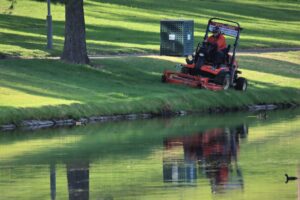
Grass is a great natural and organic material that, when maintained properly, can be very sustainable. Grass can either be ground into clippings or left to decompose to fertilize your soil. Mowing the lawn at the right time of day will help you achieve better lawn health and appearance.
When it comes to mowing your grass, there are two main schools of thought—mow before rain or after it. Here, are some pointers on which approach is best for you.
Mowing before rain
You can generally cut your grass anytime of the year. But in general, do not mow your grass before it is wet outside. When it rains, rain water can infiltrate the roots of your grass, so if you cut your grass when it’s wet, water can get into the root system, which can cause damage.
During winter, you can use a watering system to water the grass. You can set the timer to beep on and off with the sun, but leave the water running or adjust the tank. This system keeps the grass hydrated, but it still limits its ability to absorb any moisture. You can do this before the grass gets too tall so it doesn’t suffer from the lack of water.
Benefits of mowing before rain
During the growing season, your grass requires light to continue growing. If the sun hits the turf too directly, this will cause more stress on the grass roots and result in a faster-than-usual rate of deterioration. Without a light layer of moisture under the grass, the roots can’t absorb as much moisture. As a result, the turf quickly dries out and is susceptible to disease and insect infestation.
Mowing before rain, or as soon as a shower starts to pass through, will reduce the chances of needing to mow at a later time. When your grass has plenty of moisture to grow under, you will not need to cut the grass as often. Because your grass will have more time to grow in, it will produce the best, healthiest lawn possible.
Drawbacks of mowing before rain
A wet lawn will not evenly dry out as quickly, and the plant may suffer a slow but steady degradation, which, over time, can create a buildup of soil and water around the base of the grass. While wet grass provides a much better balance of moisture than dry grass, a wet grass does not make for a healthy lawn.
Unlike grass, grass is not sensitive to rainfall and will grow with or without regular rain. This is in part because moisture is necessary for the grass to photosynthesize and convert sunlight to energy for plant growth. As a result, grass has an efficient absorption and metabolism of water. This allows grass to adapt to short periods of heavy rainfalls with little or no harm to the grass.
Mowing after rain
The first step is to realize that when it comes to mowing your grass, there are two schools of thought: mow before rain or after it. This means that in order to get the best and most thorough results, you need to look at what causes the most problem for you.
Before rain causes the most trouble for most people—both because the soil is wet and because the lawn is harder to mow. This makes the lawn hard to mow. Plus, the moisture content in the soil is much higher than when there isn’t any rain. The result is uneven growth on the lawn.
Meanwhile, after rain tends to be much easier on the lawn because the soil is not so wet and the grass is a little softer. In addition, the grass is not as high, making it easier to reach.
Benefits of mowing after rain
Mowing after rain helps prepare your lawn for the upcoming season, which can help achieve better quality. Mow the lawn at a time when the grass will be at the bottom of its growth cycle to help replenish nutrients and water for growth in the upcoming season.
Better rooting: “Mowing wet and aerates the soil so the grass roots don’t get as dry as they would with a dry mow,” said Cody Byrum, Director of Horticulture at Pioneer Landscaping. “Mowing wet and aerates the soil so the grass roots don’t get as dry as they would with a dry mow,” said Cody Byrum, Director of Horticulture at Pioneer Landscaping.
Less weeding: The less weeds you have, the less work you’ll have to do, said Byrum. “If it is already weeded, you don’t need to mow.
Drawbacks of mowing after rain
As you might have guessed by now, mowing after rain is not an ideal choice for most people. A couple of things to keep in mind are that the lawn can be drenched with water and the ground can become muddy. Additionally, after a good rain, the soil tends to be wet and the grass may turn brown.
The lack of direct sun in the middle of the day makes it challenging for grass to reach optimal temperatures during that time of day also gives grass a challenge of reaching its best growth phase. In the middle of the day, the grass isn’t receiving proper photosynthesis, which is the process of turning sunlight into food for the grass.
Conclusion
The key to having a healthy lawn is to mow it daily, but it doesn’t have to be on the same day every day.